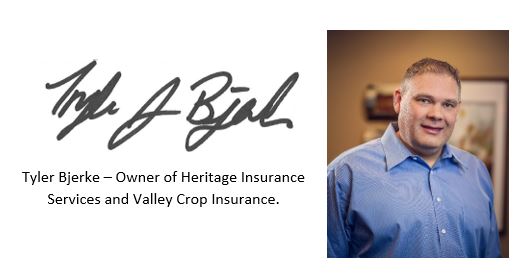My apologies, it has been a while since our last correspondence. As of today, we have a record number of production reported, submitted, and approved in January. This is a stark contrast to years past. It is important for the agency to have the most current data set in your policy to accurately quote & recommend coverage for the 2021 crop year. If you have not finished production yet, please do so at your earliest convenience. The agency is putting the finishing touches on our spring update meeting. This year’s meeting will be on a flash drive that will be distributed to our current clients. The idea is that you may watch on your own time schedule all or parts of it at a time. We hope to start distributing the first week in February (check your mail). I have included commentary for some important changes and updates to programs over the past year. Please read carefully and consult your local FSA for procedures to modify or apply. We continue to work each day for our insureds and look forward to this spring with a renewed sense of optimism. As always, you may contact myself or any of the agents for further details or questions.
For Specialty Crops (“sales” based commodities) that received CFAP assistance based on a percentage of their ’19 income – This rule officially implements the legislative change included in the end of year bill to include crop insurance indemnities and ’19 WHIP+ payments in the calculation of income, so that farmers who had a loss in the benchmark year are not dinged again. For row crops (“price” based commodities) that used APH to generate per acre payments – The rule fixes various situations where the APH info did not carry through. (e.g. area plans, etc.) The acreage had been knocked back to an 85% of ARC county average, by upping that plug to 100% of the ARC county average if the ground was in fact insured. Dry beans & honey are examples of crops affected.
Formula for Total Sales in 2019:
MPCI Indemnities + WHIP+ + Total sales = Total receipts available for payment
Paycheck Protection Program (PPP) Amendments to Round 1 and Additions for Round 2
The PPP loan program was reauthorized so that remaining funds from last year could be used, and new funds were provided for a new round for those who can document deep losses in 2020 as well. Enrollment opened this week for some smaller banks, and larger banks will follow close behind.
For the remaining funds ($140 billion) from the first round of the program, modifications were included to better assist smaller farmers and ranchers with few or no additional employees who file a schedule F for tax purposes. In the past, farmers and ranchers were required to use net profit, line 34, on the schedule F to determine payroll for an operation with a no employee payroll. This has now been changed to allow farmers to use gross income, line 9, instead for their personal payroll for the purposes of self-employment. If a producer’s gross income is higher than $100,000, the producer will be limited to $100,000 to calculate salary, which effectively means one may qualify for a PPP loan of up to $20,833. Consistent with the past, this loan will be forgiven if certain conditions are met. This calculation changes if the operation has an employee payroll, but most farms with significant payrolls were already taken care of in the original formulation last year.
A new round of PPP was also authorized and funded (an additional $284 billion), but as we noted in our December 21 summary, it is really designed for industries and small businesses other than agriculture that have suffered deeper losses due to the pandemic (e.g., one of the requirements is one must prove up a 25 percent loss of revenue in a quarter to qualify). An additional requirement for the second round of PPP loans is obtaining a first-round loan and using the full loan amount. Most farmers who can benefit from these provisions will be modifying their first loan or taking out an initial PPP loan under the new calculation.
Anyone considering a PPP loan should discuss the decision with his or her banker.
COVID-19 Relief Package — Agriculture Provisions
We want to provide you with a status update on the roughly $13 billion worth of agriculture provisions in the COVID-19 relief package that we had originally documented in our December 20 newsletter. While we had hoped some of the aid could be distributed very quickly, even before the January 20 Inauguration and transition, it appears that only a small rule will be issued before January 20 governing small components of the package while the lion’s share of COVID-19 relief for agriculture will have to wait for a new rule making under the next administration. Despite this, many of the key provisions of the package are mandatory and prescriptive, meaning the Secretary is required to provide the aid and to do so in a very specific way. We provide a list of some of the major agricultural provisions below, as well as a link to a more in-depth summary.
-
$20 per acre payment to price trigger and flat rate crops.
-
Note: this is mandatory and should not require a new sign-up, but rather should use CFAP-2 certified payment acres.
-
-
Specialty crop eligible sales calculations must now include crop insurance indemnities and WHIP+ and NAP payments and the Secretary may allow producers to substitute 2018 sales for 2019 sales. The inclusion of crop insurance and disaster payments in sales calculations is mandatory, but it may still be a little more complex in its implementation than the program required under the first bullet, above.
-
Payments to livestock and poultry producers forced to depopulate animals due to insufficient processing access, based on 80 percent of fair market value as well as cost of depopulation, less any payments made for such purposes under EQIP and state programs. This was a big problem in April, but Secretary Perdue asserted that he did not have legal authority to indemnify producers for euthanized livestock. This is also a mandatory provision, although the Secretary has discretion to determine the fair market value.
-
Cattle payments to eliminate some of the disparity in payments relative to the April 15 date as well as with respect to breeding stock. This is a mandatory provision but may require a new signup given the many categories.
-
Payments to contract growers of livestock and poultry of not more than $1 billion to cover not more than 80 percent of losses incurred from January 1, 2020 to the enactment date. This is a mandatory provision, but the Secretary has the discretion to determine losses incurred.
-
Payments to textile mills for the March 1, 2020 to December 31, 2020 period. This is mandatory.
-
Compensation to producers under CFAP-I and CFAP-II that more closely approximates actual losses while using a broader definition of income derived from agriculture for AGI purposes (including gains, services, sale of agricultural real estate, prior year net operating loss carryforward) but not to exceed calculated gross payment or 80 percent of losses. This is mandatory notwithstanding AGI and payment limitations but subject to available funds and takes into consideration needs of other programs under the COVID-19 agriculture relief package.
-
Assistance to processors for losses of crops due to insufficient processing. This is a discretionary item that the Secretary may use if there is COVID-19 disruption in processing.
-
Authorization of the Secretary to extend any marketing loan for up to a total of 12 months.
-
At least $1.5 billion in food purchases to be distributed to the needy.
-
Authorization for payments to biofuel producers. The Secretary has the discretion to make such aid available and we anticipate that incoming Secretary Vilsack would be favorably inclined.
-
Recourse loans available to dairy product processors, packagers, and merchandisers.


